
|   |

|   |
 e-mail: sunilkothari1933@gmail.com 12th edition of Erasing Borders Dance Festival 2020 Photos courtesy: IAAC October 24, 2020 From September 20 to 27, 2020, Indo-American Arts Council, New York, presented the 12th edition of Erasing Borders Dance Festival. Moving to a virtual format has its own artistic challenges. Deepsikha Chatterjee, the new director of the festival, says that for the first time, in its 12th year the festival has brought 11 artistes together in a virtual borderless. She further informed that it had more than 200,000 viewers in total with approximately 17,000 tuning in each day of the festival. I viewed the performances featuring interviews with dancers and curators Uttara Asha Coorlawala, Parul Shah, Deepsikha Chatterjee, Shruti Mohan and various other interviewers. The dancers were introduced and asked about the dance form, its history, process of creating and then screening of the performance.  Shambhu Nath Karmakar group The first performance was a group dance of masked Purulia Chhau dancers of West Bengal, led by Shambhu Nath Karmakar of Ashpara Care Club with 11 performers and 4 musicians, drummers, singers. They presented Mahishasura Mardini, the most popular theme of Goddess Durga annihilating the buffalo headed Mahisha demon. It is full of veera rasa, and has martial spirit. I had seen Purulia Chhau for the first time in Purulia village during my research in 1971, then its presentation at Sadler's Wells in London. Over the years of course the form has further developed and so have the masks and costumes. The masks are now much larger and colourful, so are the costumes. The dancers walk in a veera chaal, martial stance and take somersaults, falling on their knees on the ground to loud and exciting drumming. Ganapati and Kartikeya, sons of Lord Shankara, appear dramatically. The filming was done on natural village ground. The entry of Mahishasura with his companions was an addition, so was Goddess Durga with her two female devotees. The lion, vehicle of the multi-armed goddess, also accompanies her and attacks Mahishasura. The battle scene is most fierce and finally Mahishasura is killed by Durga piercing his chest with a trident. The tableau like finale is most picturesque and visually stunning. During the interview, Shambhu Nath said they rehearse and perform for three months, else they are busy cultivating land. He also works as a motor mechanic. The troupe manages to rehearse for the Chaitra Parva Festival in April. They have performed internationally. All dancers were extremely well trained and performed with vigour, least bothered about the physical injuries while falling on the floor. 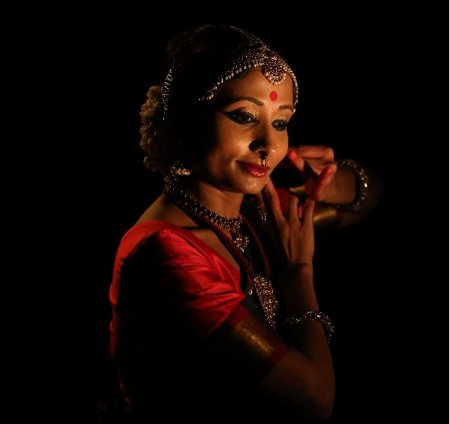 Neha Mondal Chakravarty On 21 September, two artistes were presented - Neha Mondal Chakravarty in Bharatanatyam and Krishnakshi Kashyap in Sattriya. Parul Shah interviewed Neha and Deepsikha Chatterjee interviewed Krishnakshi. Neha Mondal Chakravarty presented two items in Bharatanatyam. The imprint of Kalakshetra training was distinct. She selected an excerpt from Lalgudi Jayaraman's Navarasa varnam, centering on compassion by Goddess Meenakshi, resplendent in beauty like thousands of suns. Karuna, compassion was emphasized with varying moods whereas Kali killing demons Chanda and Munda and as mother lovingly caressing and protecting, suggested protection from all hazards, including Corona virus. The navarasas were suggestive but main rasa was of Karuna. Rendered by Sudha Raguraman in Bibhas raga, it evoked the mood beautifully. In Jayadeva's ashtapadi Sakhi he keshi mathanamudaram, the shringara was epitomized as per the lyric, when she confided to her sakhi about her first encounter with Krishna. The narration was charmingly danced enacting the love play, Krishna undoing her clothes with sweet nothings and kissing her, she overcome by shyness; the expressions were dignified and registered with restraint. The flowery bed prepared by Krishna and their physical union transporting her to a state of ecstasy merging the atma with paramatma was depicted suggestively. Rendered with feeling by vocalist O.S. Arun, it succeeded in evoking the erotic rasa. Neha explained her items prior to performance that also showed the process. 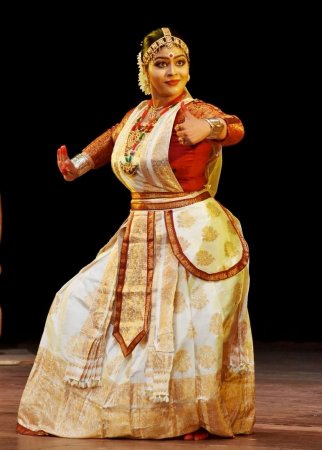 Krishnakshi Kashyap A student of Guru Jatin Goswami in Guwahati, Sattriya dancer Krishnakshi Kashyap presented Ram Niranjan prayer from Gunamala of Sankaradeva. The Lord Rama who removes all sins and unhappiness, in his Krishnavatara plays flute, and protects his devotees from troubles. When Indra sends rain, wanting to be worshipped instead of Krishna, he lifts mount Govardhan, subjugates serpent Kaliya. As Rama he kills ten headed Ravana, takes ten incarnations, and protects the four Vedas. With sancharis, Krishnakshi embellished the item with cosmic form of the Lord taking different incarnations. Kavits like mnemonic syllables was employed to narrate the story. With impressive abhinaya she registered the expressions competently. In pure dance item known as Raja Ghoria Chali, pronounced as Sali, with basic posture Prakriti Ora for women, Krishnakshi progressed with nritta including mati akhada (physical exercises) woven into the technique. This item was specially performed for the visits of royal personages and therefore was for their entertainment. Else the other chalis are in form of pure abstract nritta, and are often performed along with Bargeet. The filming was done with the backdrop of Namghar as seen in Sattras - monasteries in Assam - and evoked the natural setting. Krishnakshi has mastered the technique and has attractive stage presence. She divides her time between Guwahati and New Delhi. She feels the pandemic has induced her and majority of dancers to look inwards into their souls and find spirituality and look forward to overcome the anxiety of Corona virus by devoting their time to exploring the form and seek more understanding and meaning to meet the challenges of difficult times. 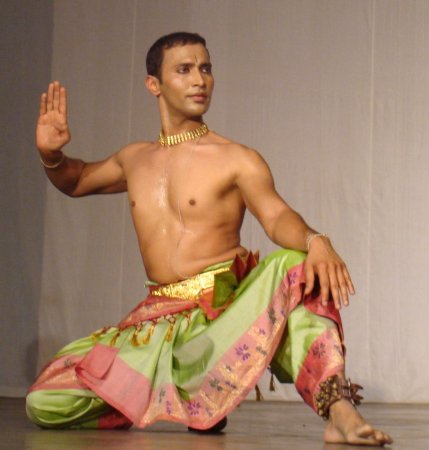 Ganesh Vasudeva The next day featured California based Ganesh Vasudeva, earlier trained by Srilata Suresh and later on by various gurus and currently studying abhinaya under Bragha Bessell. He presented the theme of Gangavataranam, descent of Ganga at the request of Bhagiratha, based on Mysore Sadasiva Rao's composition in raga Poorvi Kalyani in rupaka talam. The choreography by Ganesh based on Bragha Bessell's had an interesting twist. When proud Ganga agrees to descend, she asks Bhagiratha, who can receive her. Bhagiratha begs Lord Shiva to receive her in his matted locks, where Ganga descends with full force. For that, Ganesh and the vocalist used mnemonic sollus full of power and for Lord Shiva receiving her, they used swaras juxtaposing the descent. Ganga is caught in Shiva's jata and has to descend, so she resorts to a clever ploy; as a trickle she runs through the eyes, including third eye of Shiva, passes through his nose, so he cannot breathe and touches his lips as a mark of love, which Shiva understands and lets her flow on earth. Bhagiratha shows the path to flow. He alternates with nritta, and has clean lines in diagonals, strong footwork and delicate abhinaya as Ganga. For the various stages of Ganga as Mandakini and by different names, Ganesh has used different gaits. Ganga is a water goddess. Ganesh interprets Ganga as a female protagonist, a powerful woman and attempts to bring contemporary touches in his choreography. The Kshetrayya padam was about Krishna promising three maids - mugdha, inexperienced in love, pragalbha, confident of her love and proudha, who keeps her paramour under control. The promise given to mugdha slyly kissing her, to pragalbha, taking her to a garden and making love, and to proudha making her believe he is marrying her, and runs away provide humour to Krishna's pranks. Bragha Bessell's choreography etches the three stages of a nayika which Ganesh portrayed clearly. The Tamil Javali by Subbaraya Iyer deals with the five arrows that Kamadeva shoots at the nayika when her husband, none other than Muruga is away. She warns Kamadeva that she will complain to Muruga for harassing her with five flowers which create various desires and states in a nayika, the last flower Aravind making her crazy. His depiction was done with grace and displayed his abhinaya skills. 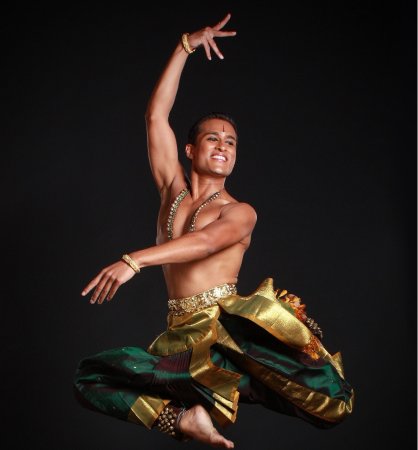 Arun Mathai On 23rd September, we saw San Jose based Arun Mathai, a disciple of Sundara Swaminathan, Viji Prakash and learning from Rama Vaidyanathan during workshops held in Liverpool, and visiting Delhi. He spoke of what is going on in the world right now, of murders of blacks, the oppressive system, to promote harmony for South Asian racial community. With huge backdrop of 'Black Lives Matter', Arun clad in regular attire of shirt and trousers, performed Shivoham as choreographed by Rama Vaidyanathan. He covered the space, playing damaru, with rendering of 'Shiva Shiva Shiva,' took utplavanas, jumps, with various poses of Shiva, the activities of destruction, balance and creation. Shiva is in each one of us and with every breath achieving peace. The juxtaposition with big backdrop was indicative of the racial disharmony, which through prayer one can restore, was metaphorically suggested. Arun regularly performs on current topics of racial inequality advocating peace among communities. Sandhya Raju was to present Kuchipudi, but she withdrew giving a reason that the item she has studied form Vempati Chinna Satyam is copyrighted and she does not want it to be imitated or copied. 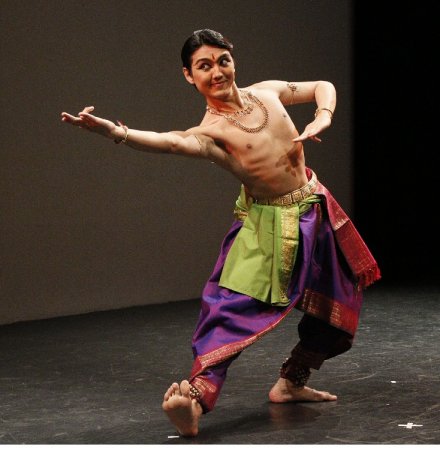 Damir Tasmagambetov On 25th September, young male dancer Damir Tasmagambetov from Kazakhstan presented three items. He had some training in Russian ballet but when he saw Kalakshetra performing a dance-drama during their visit to Kazakhstan, he fell for Bharatanatyam and came to Chennai to study in 2006. Parul Shah interviewed him. Tasmagambetov said that his country and India have several things in common and is closer to India. He was deeply moved by the spiritual content of the form as he studied at Kalakshetra and his attempt has been to integrate the spiritual element and peace with this pandemic period. Through his dance he wishes for peace the world over. He presented three items - Ganesh Vandana, extract from 7th canto of Kalidasa's Kumarasambhava, preparation for marriage of Shiva as choreographed by Leela Samson to the Hindustani music by Madhup Mudgal. Prayer to Ganapati in Valachi raga rendered by Rukmini Ramani was evocative of asking the Lord to remove all obstacles, suggesting the present calamity that the world is facing. His style bore the stamp of Kalakshetra with precise movements and rhythm, use of hastas and iconic figure of Ganapati. It was brief but he at once established his credentials having mastered the style. The Kumarasmabhava piece was narrative and alternated between nritta and abhinaya. Lord Shiva's aharya is described by Kalidasa in detail - the various garments selected for the Lord, the vehicle Nandi on which he would ride, his attendant Ganas and Bhootas, and the marriage procession. It had more of narration which he created with his modest abhinaya and sparkling nritta. The third brief item was Shanti Mantra: Sarve janaha sukhino bhavantu, let the people of the entire world be happy and have peace. As he said in his interview, his prayer was for all to have peace. He believes that the whole world is waiting for peace. In that sense he concluded his dance as relevant in present times. 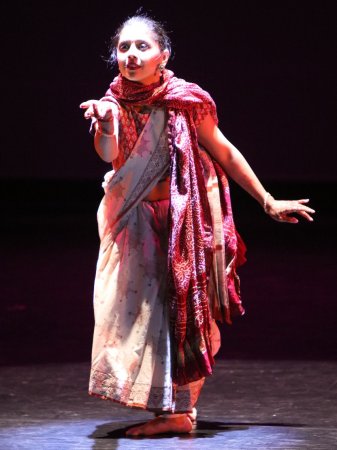 Barkha Patel Next artiste was Kathak dancer Barkha Patel based in New York, whose work was completely out of the box, unusual and innovative in terms of weaving it in Kathak repertoire, along with contemporary dance movements. She herself also sang Ananda no Garabo, the folk dance from Gujarat, balancing earthen pot on head while performing the folk dance Garabo - Aaj mane ati ghano ananda vadhyo, a composition of Vallabh Batt, meaning, "Today O Mother Goddess, I am feeling blessed." During interview, Barkha told the interesting story of her pilgrimage on foot with her parents to temple of Bahuchara Mata (near Pavagadh in Gujarat), who is presiding deity of community of third gender known as hijras. The pilgrimage involved lot of rituals also, pulling the chariot on road in which is seated the image of Bahuchara Mata. The rituals contain whole night singing of bhajans, kirtans. Also while performing in circle, as Garabas are danced, Barkha took circles with two arms and bending as if in a trance and having convulsions. She used mnemonics of Takita takita with three syllables as in Kathak which suggested three states of the goddess, sattvika - higher state, rajasik - middle stage and tamasik - the lower stage, to describe internal turmoil. She raised her hands in a final movement, known as Akinchan mudra, begging the goddess to hold her hand as a mother would of a child. During the interview, Barkha told the mythological story that once dacoits attacked devotees of the Goddess and the devotees cut off their breasts to cure themselves of the attack by dacoits and dressed as women. She explained that is why the hijras dress as women. It was quite an intriguing ritual and tale. In terms of dance, being a trained Kathak dancer, knowing well her Gujarati roots, performing Garabo, Barkha introduced freewheeling movements while singing, at times the aalap, only tune rendered to suggest convulsions and so on. Through this dance presentation, Barkha expressed her intent to connect with the community of hijras on margins of society. It was quite a bold attempt and unusual. 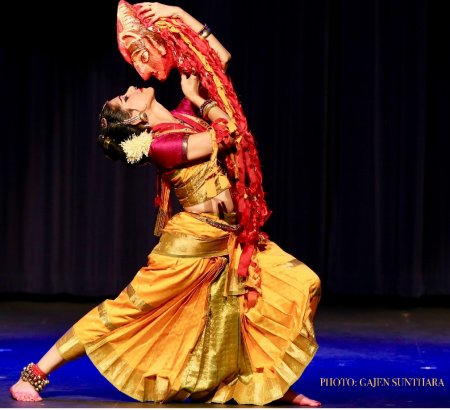 Mesma Belsare On 26th September, Boston based Bharatanatyam dancer Mesma Belsare presented Shilpa Natana, a form choreographed by senior dancer Maya Kulkarni. Maya has called it Shilpa Natana, as she has taken several elements from sculptures like Gandhara, Maurya, from the frescoes of Ajanta, as was seen in Mesma's hairdo and various ornaments. Maya explained that she wanted to move away from regular Bharatanatyam Margam which she had studied in India. Uttara Asha Coorlawala interviewed Mesma and Maya and lot of information of the process of creation of the item was given. For Maya, classical music was equally important, but dance took the precedent. Her father was fond of Sanskrit literature, which Maya studied and she brought Sanskrit similes, metaphors from poems of Kalidasa such as Kumarasambhavam and Raghuvamsham. Thus her repertoire differed from Tamil compositions. She found in Mesma a vehicle which would reflect and express her concepts with a more pliable body. The use of Sanskrit shlokas, the recitation with names of several rivers Saraswati, Kaveri, Ujjval Ganga, Sarayu, Vetravati and then taking saptapadi, where priest announces the seven steps one takes while marrying the bride, suggesting marriage of Shiva and Parvati, using Nasadiya sukta, not for explaining creation of Universe but desire in Shiva to marry Parvati, thereby referencing concept of Ardhanarishwara, half male and half female, but depicting them separately as Shiva and Parvati. Since Shiva has attendants Nandi, Ganas and Bhootas, Maya suggested to Mesma to show the movements of Nandi whirling joyously with his head, creating an element of humour. Shiva embraces Parvati and has physical union; we hear the sound of conch and bells, the time of evening is evoked as a palpable element of time. The work thus is multi-layered. Mesma Belsare was trained in Bharatanatyam under Shankar Hombal and later on under Geeta Chandran. She further studied Sanskrit, painting, costume designing, sculpture and allied arts. Her costume was designed by her with her selection of colour, which Uttara Asha Coorlawala commented upon as having a painterly look. The collaboration between Maya Kulkarni and Mesma Belsare has resulted in creation of an outstanding work which has received encomiums wherever it has so far been staged.  Vishwakiran Nambi On 27th September, contemporary dancer Vishwakiran Nambi was interviewed by Uttara Asha Coorlawala. He with six members of his company from Bangalore was unable to participate earlier as last minute the visas of his company and himself were cancelled and none of them could make it. This year, Vishwakiran screened video of his work, the location from where he works with Nritanrutya and Mayuri Upadhya giving viewers various facets of his process of creating works. Vishwakiran spoke of body becoming mirror, experiences of life, building blocks. He showed Loka, his creative place or centre for developing art, an incubation box. He spoke of collaborative work, and of his philosophy of narrative expression. He spoke of dance as a language, as abstraction. In his video of his process and environments, he showed the urban eco system of Bangalore with its congestion, yet still offering multicultural experience, explaining that he heard daily around him, and spoke six languages. In one clip his dancers were exploring movements of mouse behaving like human being, while creating solo work Trishanku. It was during Nambi's visit to Toronto for a dance festival that he got interested in film and digital form. He felt alive making art through the eyes of a camera. Pyre, his dance work was inspired by having watched people walking on live burning coals, and folk movements. It meant human struggle, perseverance, physical disciplines, physical exhaustion, with the actual piece pushing to the point from where one cannot move, and then starting from there! The actual piece took shape from there on with seven dancers. Two dancers bend, another rides over them, barely balancing. Seven dancers fall rolling on the floor, while one lone female dancer is walking. The group holding onto one another form a pyramid, while one dancer attempts to climb on the top. The dance continues with jumping, moving frenziedly in circles, taking somersaults, dancing to the different sound textures of the drums. In one sequence, a woman dancer is carried on shoulders like carrying corpse for placing on a pyre; the image of walking on fire, yellow light suggesting leaping flames with arms raised. Pyre as a test to purify the spirit that exists inside one's being. That journey was well conceived and performed. All in all, this festival offered an amazing feast of dances.  Dr. Sunil Kothari is a dance historian, scholar, author and critic, Padma Shri awardee and fellow, Sangeet Natak Akademi. Dance Critics' Association, New York, has honoured him with Lifetime Achievement award. Post your comments Please provide your name and email id when you use the Anonymous / blog profile to post a comment. All appropriate comments posted with name and email id in the blog will also be featured in the site. |